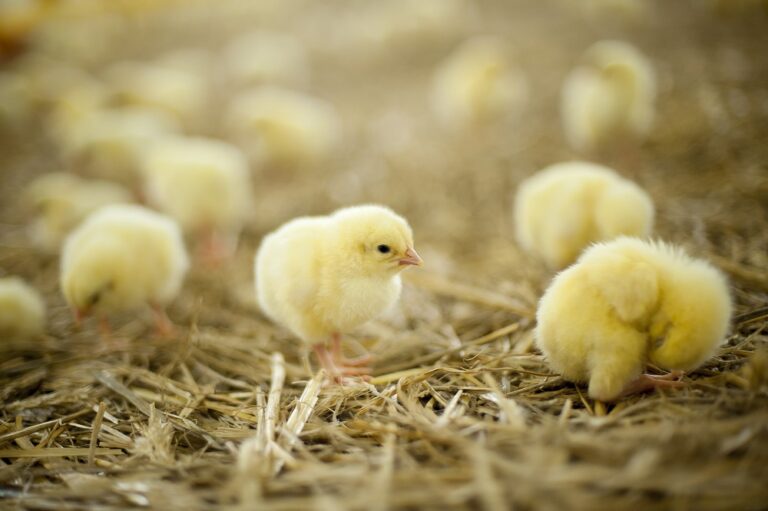Improving pre-starter nutrition can bring long-term wins
A young chick only eats about 100g of feed from birth to day four or day four. The exact amount will vary depending on the breed, but this relatively small volume of feed holds the key to future productivity.
The chick’s first feed is a pre-starter, given soon after hatching when the chick is transferred from the hatchery to the house, or provided soon after hatching in an in-house hatching system.
Alongside good environmental conditions and management, this pre-starter is responsible for weight gain, with the target for a seven-day standard body weight of 122g for a Ross bird, or 108g for a Cobb bird.
“But more advanced knowledge in young chick nutrition is enabling us to feed a better-designed and nutritionally-improved pre-starter and achieve higher feed efficiency,” says Cargill’s technical poultry specialist Daniel Palcu. “We can also use the diet to promote the immune system and support longer term productivity with a healthier bird.”
Research has shown that increasing seven-day weights has a carry-over effect, and each extra 10g of body weight above the standard at seven days old results in improvements in body weight of 50g to 80g by 42 days.
“If farm management and health is optimised, and we can improve pre-starter efficiency, it should be possible to achieve an extra 25g at day seven, with the potential of adding 125g or more to end weights,” he adds.
Very young chicks rely, in part, on residual yolk immediately after hatching for nutrition and to support their immune system and health. “While the yolk is nature’s little sack of goodies, and chicks can survive on this for few days, this can promote stress which will have a big impact on performance in the early days.
“Delays in pre-starter intakes and substandard diets can affect performance, including physiological development and weight gain. This is potential that is being wasted on some of our units.”
To promote early growth, and more robust and uniform chicks, we look for accelerated yolk-sac absorption and for the chick to transition more quickly to complete feed.
He encourages the use of pre-starters as soon as possible after hatching, to maximise the chick’s potential, both in immune system development and growth.
“In fact, within the next few years Europe is expected to legislate that newly hatched chicks must be provided with feed immediately, both in hatcheries and in transit ahead of arriving on farm.
“We may see the UK Government adopt similar legislation, so hatchers and farmers who facilitate this earlier intake of pre-starter could see performance advantages and future-proof their businesses from a welfare perspective.”
Early access
Early gut maturation, good enzymatic activity and the development of the immune system, with its associated health benefits will benefit from early access to a good quality pre-starter and translate into improved technical and business performance.
“The intestinal tract is not fully developed in the very young chick,” adds Palcu. “Digestive enzymes are low after hatch, so when the young chick has its first feeds, the new, more complex nutrients cannot be digested.
“Relatively low digestible protein, such as sunflower meal or rapeseed, will create a substrate that’s ideal for harmful bacteria to develop, such as Clostridium or Salmonella, which thrive in an environment based on undigested protein. This can also result in digestive problems.”
New research in early nutrition shows the importance of specific ingredients with high digestibility on immunity, gut development and overall growth.
A good pre-starter will also include specific additives offering modes of action that can have a targeted effect on areas involved in performance and health, such as on the epithelial gut membrane or bone mineral content. Use of these additives can be specific to a unit.
“Packages with organic acids and essential oils compounds are used for gut integrity and immune response, for example. These are two areas that have often been ignored in pre-starter formulations.
“Where mortality rates from leg issues are high – on some units these can account for more than two thirds of deaths in broiler systems – including specific protected minerals can play a crucial part in bone mineralisation, preventing the microfractures that can occur in the femoral head.
And additives with specific medium-chain fatty acids can improve the gut microbiota profile. Microbiota is important in promoting gut health.
“New knowledge is enabling us to design pre-starters that use these groups of feed additives, together with the appropriate feed enzymes that encourage maximum nutrient use, to promote early chick health and performance.”
Pellet quality and size are important characteristics of a good pre-starter diet, alongside good quality raw materials formulated to maximise digestibility and health.
Pre-starter diets in mini pellet form are gaining popularity and replacing meal that had limitations such as enabling chicks to ‘sort’ and select some ingredients over others.
Recent knowledge has led to advancements in pre-starter broiler diets that are bringing some significant benefits to the health and productivity, not only in the short term, but across the lifecycle of the birds.
“By feeding a well-designed pre-starter feed we can expect birds to achieve higher carcase weights, with greater uniformity, improved welfare and with fewer setbacks, such as leg issues.”


